The Tower Handbook
13.10: Advanced method learning
a: Why is learning more complicated methods different?
There is more to learn, but the biggest difference is that it tends to be more joined up in a continuous string with only short bits of plain hunting [195], unlike Plain Bob where it is all plain hunting except at the leads. This affects the way you think about the method. In Plain Bob, if you are ringing the 2nd do you think '3-4 down' as the first thing to do, taking the hunting for granted? If you run in at a bob do you think 'dodge 3-4 down next time'? This is fine for Plain Bob, but not very helpful for most methods for two reasons.
- It can be a long way to the next lead, and you need to know what to do now. In Cambridge Major there are six dodges, a double dodge and a place before you get to the next lead.
- What you do at a bob is the same in almost all methods [196] but what you do afterwards varies greatly with the method. You do not want to learn a new set of rules for the bobs every time you learn a new method.
You can solve both problems if you learn the place bells of the method.
b: What is the best way to learn a method and why?
Thoroughly, using several different complementary methods because that way you are least likely to go wrong and most likely to be able to put yourself right if you do. We all make mental slips when ringing but whether you actually go wrong, as seen by the other ringers, often depends on whether you have an alternative view of the method to fall back on. If you have learnt some landmarks (like where you pass the treble, or where you meet your course bell) then even if you go wrong you may be able to pick up the thread again. Better still, if you can learn how the different parts of the method fit together (method structure) you are likely to be able to work out what you are doing from what is happening around you. Even the blue line can be approached in different ways. Look for patterns and symmetries to help you remember what comes where.
c: Do I need to bother with the theory?
Yes. It is worth sitting down with pencil and paper to work out some of the figures, the structure, the blue line, where you pass the treble, where you meet your course and after bells, what work fits with what, and so on. Even if you have the method already printed, drawing it out in different ways will help it to sink in. When rehearsing a method to see whether you know it, don't look at the book first. Try to work it out in your head and then check whether you got it correct. This is gives you a better indication of how much you really know.
d: How can I memorise the blue line?
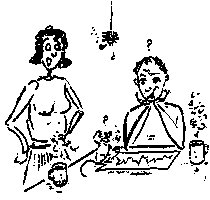 Most people use a combination of visual and verbal memory. They recite the words while visualising the picture. In both cases, the job gets easier if you can group the little bits into big chunks with a recognisable pattern and a simple name. There are standard and semi standard names for these.
Most people use a combination of visual and verbal memory. They recite the words while visualising the picture. In both cases, the job gets easier if you can group the little bits into big chunks with a recognisable pattern and a simple name. There are standard and semi standard names for these.
- Some are unique (eg Yorkshire places).
- Some have different meanings in different methods (eg front work).
- Some are perversely tautological (eg 'long London', in London [197]).
- Some are ambiguous (eg Stedman, for a Stedman whole turn).
Whatever technique you use, try to learn the method before you come into the tower – see picture.
See section 15, figure 15-2 for some examples of named work.
Remember that plain hunting in complex methods is rare, so it is worth learning where it happens. Where there are any odd blows or places, work out whether they are at handstroke or backstroke. Also note which parts of the work are done with particular bells (e.g. the treble). Most methods are symmetrical so each piece of work will be repeated in reverse somewhere else in the method. The work that spans the points of symmetry is itself symmetrical (eg 3rds place bell in Cambridge).
e: What are place bells?
For example, 7ths place bell refers to the portion of the work rung by the 7th during the first lead of a plain course. In other words if you chop up the work into chunks, each a lead long, each piece is named after the bell that starts at the beginning of it. Each place bell [198] starts and finishes at the backstroke of the treble's full lead [199].
f: What is the place bell order?
The order in which the place bells follow each other through the method [200]. If you look at a method written out with the starts printed (eg as in The Ringing World Diary) the order in which they come is the place bell order. For most methods [201] the number of place bell orders is very limited (two [202] less than the number of bells).
g: How can I work out the place bell order?
If you have the whole method written out as above (or as a blue line) with the starts marked, you can just read it off. If not, work out the first full lead of the method ending with the lead head (treble's backstroke). From this you can work out the order quite simply. Start with 2 (say). See what place it ends in at the first lead head (4ths place in the first example below). Now see where the 4 ends (6ths place), then where the 6 ends (5ths place) and so on until you get back to 2nds place. All the possible lead heads for Minor are listed below, with the corresponding place bell orders. A '(2)' has been added in brackets at the end of each to remind you that the order is cyclic with no beginning or end).
Second [203] lead head
135264
156342
164523
142635 |
Place bell order
2_4_6_5_3_(2)
2_6_3_4_5_(2)
2_5_4_3_6_(2)
2_3_5_6_4_(2) |
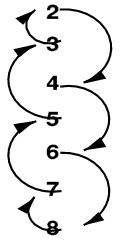
Sequence for Plain Bob |
 There is an even quicker way of working out the place bell order, once you have discovered the first step (2_4 in our example). Write the bell numbers (except the treble) in a circle going up the evens and down the odds as shown. Draw in the line corresponding to the first step in the place bell order (for our example one place round the circle). Keep going, taking the same size steps each time and noting the number at each step. The other place bell orders correspond to going round the circle two, three and four places at each step. On the diagram, this corresponds to doing a circuit backwards or forwards, round either the thick lines or the thin lines. This process works for any number of bells.
There is an even quicker way of working out the place bell order, once you have discovered the first step (2_4 in our example). Write the bell numbers (except the treble) in a circle going up the evens and down the odds as shown. Draw in the line corresponding to the first step in the place bell order (for our example one place round the circle). Keep going, taking the same size steps each time and noting the number at each step. The other place bell orders correspond to going round the circle two, three and four places at each step. On the diagram, this corresponds to doing a circuit backwards or forwards, round either the thick lines or the thin lines. This process works for any number of bells.
But watch out for some cases that don't work. If the number of working bells is not a prime number then you can find circuits on the diagram that get back to the start without going through each place. This corresponds to a short plain course with all the bells not doing the same work. The ones that do not work are:
1 of the 3 possibilities in Doubles, (2 steps ' 2 leads)
3 of the 5 possibilities in Triples, (2 or 4 steps ' 3 leads, 3 steps ' 2 leads)
3 of the 7 possibilities in Caters, (2 or 6 steps ' 4 leads, 4 steps ' 2 leads)
2 of the 8 possibilities in Royal, (3 or 6 steps ' 3 leads)
3 of the 9 possibilities in Cinques (2 or 8 steps ' 5 leads, 5 steps ' 2 leads)
See if you can work out the next higher ones that do not work.
h: How can I remember the place bell order?
You can just learn it, but if you learn the method by place bells as well, then each lead you learn will end with something like '....and become Xths place bell'. Some people just know the place bell order for a few familiar methods, and then remember the order for other methods by which group they are in. This is made even simpler, because many commonly rung methods fall into a small number of groups. Taking the major methods in The 1995 Ringing World Diary as an example the majority are either in the Cambridge group or the London group, as shown below.
| Steps |
Code (see below) |
Place bell order |
Bell in 2nds place after a lead |
Methods |
| 1 |
a,g |
2468753 |
3 |
Plain, Glasgow |
| 2 |
b,h |
2673485 |
5 |
Cambridge, Yorkshire, Lincolnshire, Superlative, Pudsey, Double Bob |
| 3 |
c,j |
2836547 |
7 |
Gainsborough |
| 4 |
d,k |
2745638 |
8 |
Double Norwich, Ashtead |
| 5 |
e,l |
2584376 |
6 |
Little |
| 6 |
f,m |
2357864 |
4 |
London, Rutland, Bristol, Kent, Oxford,
St Clements, Ealing, Belfast |
i: What are the letter codes sometimes given with a method?
They show in which order the leads come (see the table above). a to f applies to Major methods with 2nds place leads. For Royal, there are more leads, but rather than add extra letters at the end, they are added in the middle. Thus
Royal has : a, b, c, c1, d1, d, e, f and
Maximus has:a, b, c, c1, c2, d2, d1, d, e, f.
This looks odd but if you think about which bell makes 2nd at the first lead it is:
a=3, b=5, c=7, ...... d=8, e=6, f=4.
By adding the extras in the middle, the outer ones still hold good for higher numbers with the extra ones being:
c1=9, c2=11, ....... d2=12, d1=10.
When 8ths (or 10ths or 12ths) place is made at the lead (instead of 2nds), the letters g to m are used, with the extra ones inserted being j1, j2, k2, k1. Thus:
Major has: g, h, j, k, l, m
Royal has : g, h, j, j1, k1, k, l, m
Maximus has:g, h, j, j1, j2, k2, k1, k, l, m.
j: What is the pivot bell?
The pivot bell makes a place at the half lead and its path then reverses what it has just done, so its blue line is symmetrical between the lead head and the lead end, e.g. 3rds place bell in Cambridge (see diagram below). The pivot bell spans one of the points of symmetry of the whole blue line. (The other is at a lead). This is shown for Plain Bob Minimus below.
In an odd bell method (with a single hunt bell) there is no pivot bell. Both points of symmetry on the blue line are at leads (eg making 2nds and making 4 blows behind in Plain Bob Doubles). Only the treble makes a place at the half lead.

3rds place Cambridge |

Plain Bob Minimus |
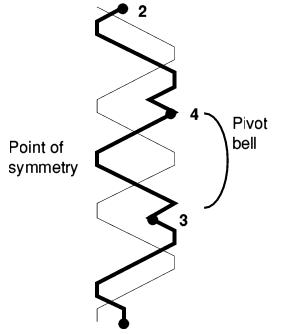
Plain Bob Doubles |
k: What is the advantage of learning methods by place bells?
There are several.
- They provide a useful division of the method so you can learn a piece at a time, which can be less daunting.
- It makes sure you really know where all the starts are.
- If you are lost, and someone tells you '7ths place bell at the lead end' it instantly means something to you.
- You automatically know what to do after being affected by a call.
Trying to ring Spliced without knowing the place bells for the methods you are ringing is extremely difficult, since at two blows' notice you could be required to ring a new lead of any of the methods.
l: What if I get lost while ringing by place bell?
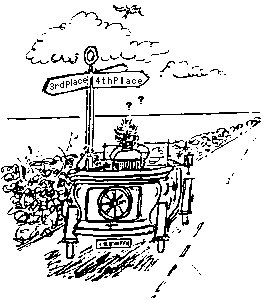 If the worst comes to the worst, you can always put yourself right at the next lead end by knowing what place bell you become. Always learn which place bell comes next as the last part of the previous one. When you start a new place bell, make a mental note of what the next one will be. This will help you survive mistakes just before the next lead, if there is either a call or a method change. Otherwise you will probably get completely lost. Use the place bells as sign posts to put yourself right.
If the worst comes to the worst, you can always put yourself right at the next lead end by knowing what place bell you become. Always learn which place bell comes next as the last part of the previous one. When you start a new place bell, make a mental note of what the next one will be. This will help you survive mistakes just before the next lead, if there is either a call or a method change. Otherwise you will probably get completely lost. Use the place bells as sign posts to put yourself right.
If you forget what place bell you are, someone else may be able to tell you. Even if you are not quite sure how far along the place bell you should be, this information can help you find your way back on track, providing you understand how the place bell works. For example, if you know it meets the Treble in 5-6, then as soon as the Treble is in 5-6 you know where you should be, and what you should be doing.
m: Can I mix place bell and other ways of learning?
Place bells provide a convenient way (but not the only way) to break the work down into manageable chunks for learning. Place bells often cut across the natural grouping, symmetries and repeated patterns of work which lead to the simplest way of describing a method. Learn these as well. And don't forget where you pass the treble, where you meet your course and after bells and other aspects of method structure.
n: How do the pieces of work fit together?
Look at the answer to this same question in the section about learning simple methods (see section 13.8h). The answer is the same, but more complex methods give many more opportunities to make use of the knowledge of how things fit. How the larger pieces of work fit together depends on the structure of the method in question, so you will need to do some homework. As well as looking for how the similar bits (like fish tails) fit together also look for things like pieces of hunting passing through the middle of sets of places (like Yorkshire and Cambridge). See section 15, figure 15.2 for examples.
o: Are there any quick ways to learn a new method?
Yes.
- Similarity to another method
eg Yorkshire has a lot in common with Cambridge. The place bell order is the same and over half the work [204] is the same.
- Trivial variation of another method
eg Quedgeley is like Yorkshire but with place-dodge-place instead of the triple dodge across the half lead.
- Familiar pieces of work
eg Cambridge front work (5ths and 2nds place bells), turns up again in a different part of Yorkshire (8ths and 6ths place bells).
- Hybrids of known methods
eg York Surprise Minor is Cambridge over the treble and London below it, see section 13.9f. Primrose is a 6ths place variant of Cambridge (a 2nds place method), see section 13.9h.
- Cryptic rules
Double Norwich Court Bob Major is famous for this with different versions in different parts of the country, eg 'near, full, far, treble bob' or 'first, treble, last, near, full, far' or 'far places near, near places far'. Of course you have to know how to interpret such cryptic rules.
As you learn more methods, you will find you can do so more quickly anyway. You will build up a vocabulary of pieces of work that helps you to simplify what there is to learn. You will find other techniques than those above. Use the ones that suit your way of thinking, but be aware that the less you know about a method, the more vulnerable you will be to any errors you (or other people) make.
Some techniques offer short term gain at the expense of depth. If you rely exclusively on them you may not learn things thoroughly. Many people ring Double Norwich just by where they pass the treble. It is very simple to learn because of the front to back symmetry, but if the treble goes wrong, then everyone else does. Touches of Double Norwich are notorious for firing out if attempted at general practices for this reason.
p: Does it matter what I call the pieces of work?
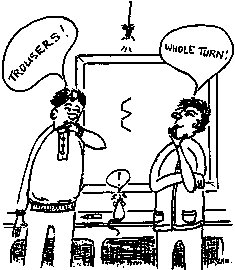 You should at least learn the standard names (or the common variants in your area) since if you don't understand them you will not be able to make use of any advice you receive while ringing. But if you find it helps you to add some private names as well to make the work easier to remember, it will do no harm. If you remember whole turns as 'trousers' because they look like (short) trousers, make sure you also know the rest of the world calls them 'whole turns'.
You should at least learn the standard names (or the common variants in your area) since if you don't understand them you will not be able to make use of any advice you receive while ringing. But if you find it helps you to add some private names as well to make the work easier to remember, it will do no harm. If you remember whole turns as 'trousers' because they look like (short) trousers, make sure you also know the rest of the world calls them 'whole turns'.
q: What is place notation?
It is a shorthand way of writing down methods. You can work out the structure of a method from its place notation, and from the structure (or grid) you can find what individual bells do. The place notation tells you which place or places are made at each change. All the other bells swap places with the one next to them.
If you look in your Ringing World Diary you will notice some small numbers printed beside the methods (usually down the left most column). These are the places made at each change. When no place is made, there is an X instead of a number. See section 15, figure 15.1-1 for an illustration.
Place notation is normally written on its own (ie not alongside a written-out lead). For the example above (Double Oxford Minor) this would be (in full):
X 14 X 36 X 56 X 36 X 14 X 12
It is normally written in a shortened form because apart from the half lead and lead end changes, the second half is a reversal of the first half. Thus:
X 14 X 36 X 56 le 12
This is sometimes abbreviated even further by missing out places in first and last place (6 in this case) which can be deduced from the others [205]. Thus:
X 4 X 3 X 5 le 2
This example is a right place method, so there is always an X to separate the changes that contain places. In wrong place methods, adjacent changes may contain places, so a dot is used to separate the numbers for successive changes, for example London Minor is:
3 X 3 . 4 X 2 X 3 . 4 X 4 . 3 le 6
See also Understanding Place Notation.
r: Are all methods like those described above?
No, some methods do not lend themselves to all the guidelines given above. Principles, such as Stedman, will require you to learn different things in order to ring them. Nevertheless some of the guidelines, like looking for rules, learning by writing out, looking at the grid etc are always applicable.
We have not covered irregular methods, which are much less commonly rung. But you can use the same general approach: looking for rules, writing out the line and looking at the structure.
s: Where can I find information about learning methods?
There are many books which are helpful for learning methods. They go into more detail than we have here. See section 2.
t: How can I learn a method so as to ring it confidently?
Here is the ideal.
- Write the method out in the three different ways. (Do write it out, don't just look at a diagram).
- The rows (at least a whole lead),
- The structure (at least a lead and a half),
- As individual place bells (the blue line snipped up).
- Learn
- the place bell order,
- the work of each place bell. (Get someone to test you).
- Learn
- whether pieces of work are at handstroke or backstroke,
- where you pass the treble,
- where you meet your course and after bell.
- Find out
- if and how the coursing order may be useful to you,
- what other bells are doing around your pieces of work,
- similarities with other, more familiar, methods.
Finally, don't panic if you cannot remember all the information straight away, keep revising it and, with practice, it will begin to stick. This is all extra learning, and we know it takes time, but it is worth the effort to learn methods thoroughly. You don't have to learn everything in one fell swoop, in fact you may find once you have started to ring the method it is easier to fit in the extra information because you see more clearly how it fits together when ringing it.
Previous

 Next
Next
Currently hosted on jaharrison.me.uk
 Most people use a combination of visual and verbal memory. They recite the words while visualising the picture. In both cases, the job gets easier if you can group the little bits into big chunks with a recognisable pattern and a simple name. There are standard and semi standard names for these.
Most people use a combination of visual and verbal memory. They recite the words while visualising the picture. In both cases, the job gets easier if you can group the little bits into big chunks with a recognisable pattern and a simple name. There are standard and semi standard names for these.
 There is an even quicker way of working out the place bell order, once you have discovered the first step (2_4 in our example). Write the bell numbers (except the treble) in a circle going up the evens and down the odds as shown. Draw in the line corresponding to the first step in the place bell order (for our example one place round the circle). Keep going, taking the same size steps each time and noting the number at each step. The other place bell orders correspond to going round the circle two, three and four places at each step. On the diagram, this corresponds to doing a circuit backwards or forwards, round either the thick lines or the thin lines. This process works for any number of bells.
There is an even quicker way of working out the place bell order, once you have discovered the first step (2_4 in our example). Write the bell numbers (except the treble) in a circle going up the evens and down the odds as shown. Draw in the line corresponding to the first step in the place bell order (for our example one place round the circle). Keep going, taking the same size steps each time and noting the number at each step. The other place bell orders correspond to going round the circle two, three and four places at each step. On the diagram, this corresponds to doing a circuit backwards or forwards, round either the thick lines or the thin lines. This process works for any number of bells. 


 If the worst comes to the worst, you can always put yourself right at the next lead end by knowing what place bell you become. Always learn which place bell comes next as the last part of the previous one. When you start a new place bell, make a mental note of what the next one will be. This will help you survive mistakes just before the next lead, if there is either a call or a method change. Otherwise you will probably get completely lost. Use the place bells as sign posts to put yourself right.
If the worst comes to the worst, you can always put yourself right at the next lead end by knowing what place bell you become. Always learn which place bell comes next as the last part of the previous one. When you start a new place bell, make a mental note of what the next one will be. This will help you survive mistakes just before the next lead, if there is either a call or a method change. Otherwise you will probably get completely lost. Use the place bells as sign posts to put yourself right. You should at least learn the standard names (or the common variants in your area) since if you don't understand them you will not be able to make use of any advice you receive while ringing. But if you find it helps you to add some private names as well to make the work easier to remember, it will do no harm. If you remember whole turns as 'trousers' because they look like (short) trousers, make sure you also know the rest of the world calls them 'whole turns'.
You should at least learn the standard names (or the common variants in your area) since if you don't understand them you will not be able to make use of any advice you receive while ringing. But if you find it helps you to add some private names as well to make the work easier to remember, it will do no harm. If you remember whole turns as 'trousers' because they look like (short) trousers, make sure you also know the rest of the world calls them 'whole turns'.